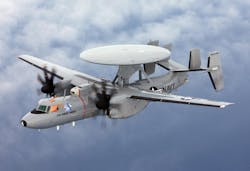Northrop Grumman to make lifetime buy of silicon carbide (SiC) radar power parts to mitigate obsolescence
PATUXENT RIVER NAS, Md. – U.S. Navy avionics experts are looking to Northrop Grumman Corp. to ensure a long-term and steady supply of silicon carbide components for radar power electronics aboard the Navy's E-2D Advanced Hawkeye carrier-based surveillance aircraft.
Officials of the Naval Air Systems Command at Patuxent River Naval Air Station, Md., announced a $10.8 million contract to the Northrop Grumman Aeronautics Systems segment last week for a lifetime quantity of 4-inch silicon carbide (SiC) transistor wafers.
The end-of-life buy is necessary to maintain production, spare parts, and repairs for the APY-9 radar’s primary power supply, power amplifier module on the E-2D aircraft.
A lifetime buy involves the purchase and storage of electronic parts in sufficient quantities to meet future demands, and is a primary way the military helps to mitigate the effects of parts obsolescence.
Silicon Carbide provides better switching performance than silicon MOSFETs and insulated-gate bipolar transistors (IGBTs) with minimal variation versus temperature, experts say.
Power semiconductors like SiC can far surpass the performance of conventional silicon power technology and make them prime candidates for next-generation high-power switching devices for military and commercial applications. SiC has demonstrated greater than twice the power density of silicon power devices and at greater efficiency.
The Northrop Grumman E-2D aircraft uses the Lockheed Martin AN/APY-9 radar for Navy carrier surveillance and theater air and missile defense missions. The AN/APY-9 provides the enhanced airborne command and control and expanded surveillance for the E-2D. The radar detects small maneuverable targets in difficult coastal-water and overland environments.
The AN/APY-9 radar for the E-2D surveillance aircraft features advanced radar signal processing subsystems to enable flexible radar beam management and enhanced target processing to help the radar pinpoint and track enemy aircraft and missiles, and reject clutter and radar interference.
Related: Army research eyes next-generation SiC military high-voltage switching devices
The AN/APY-9 features mechanical and electronic scanning modes, providing the warfighter with 360-degree situational awareness around the aircraft, and the ability to augment mechanical scanning with electronic scanning to dedicate extra resources to challenging targets or 90-degree sectors in any direction.
The AN/APY-9 Radar detects air and sea surface targets simultaneously with its space-time adaptive processing architecture, which suppresses clutter, jamming, and other sources of electromagnetic interference to focus on the target.
The AN/APY-9 operates at UHF which excels at long-range detection of difficult-to-find targets. High-power solid-state transmitter electronics increases reliability and sensitivity.
The radar has a high-reliability solid-state transmitter design, digital receivers, and exciter for waveform flexibility, low noise, and increased sensitivity. Its open-systems-architecture processor supports continuous technology insertion, and its circuit card computer hardware architecture simplifies system maintenance.
On this contract Northrop Grumman will do the work in Durham, N.C.; and Baltimore, and should be finished by February 2027. For more information contact Northrop Grumman Aeronautics online at www.northropgrumman.com/who-we-are/business-sectors/aeronautics-systems, or Naval Air Systems Command at www.navair.navy.mil.
About the Author
John Keller
Editor-in-Chief
John Keller is the Editor-in-Chief, Military & Aerospace Electronics Magazine--provides extensive coverage and analysis of enabling electronics and optoelectronic technologies in military, space and commercial aviation applications. John has been a member of the Military & Aerospace Electronics staff since 1989 and chief editor since 1995.
